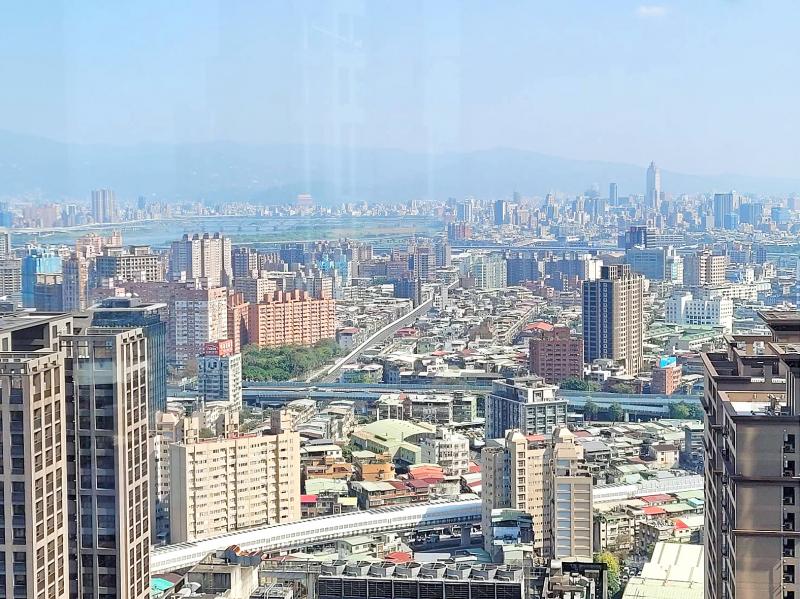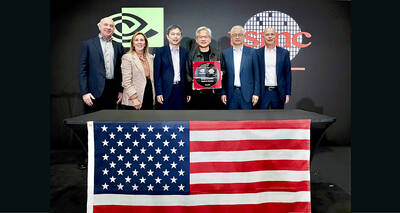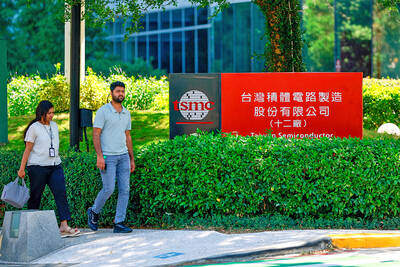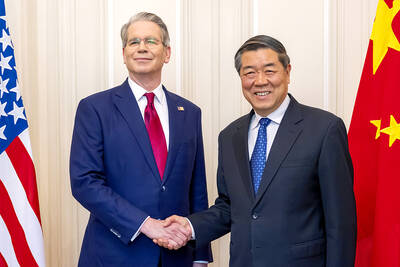New Taipei City has seen an rise in its house purchases this year, as more people are willing to take residence in second-tier locations given the high cost of purchasing a house in the capital and other major locations, Shining Building Business Co (鄉林建設) said yesterday.
As of last month, the number of households in New Taipei City rose by 10,382 from December last year, with the districts of Sinjhuang (新莊), Tamsui (淡水), Banciao (板橋), Linkou (林口) and Tucheng (土城) seeing the largest increases, the company said, citing government data.
Taoyuan and Taichung also reported growth in household numbers during the same period, while Taipei, Tainan and Kaohsiung posted declines, the Taichung-based developer said.

Photo: Lai Hsiao-tung, Taipei Times
Improvements in infrastructure and the relative affordability of homes accounted for the changes, it added.
Housing prices in Taipei are approximately 15.54 times the median annual household income, compared with 12.25 times in New Taipei City, the company said, citing first-quarter statistics from the Ministry of the Interior.
Relative housing affordability and the expansion of MRT lines have made New Taipei City a popular choice for residence, the developer said.
Additionally, major shopping malls, department stores and movie theaters have expanded their presence in second-tier locations to take advantage of their newfound population growth, it said.
Taipei’s population shrank by 44,000 people last year, while losing another 19,000 in the first eight months of this year, posing a threat to consumer activity in the long term, the company said.
Given the growth trend, rezoned areas in New Taipei City are in need of new elementary and junior high schools to accommodate new students, it said.
A rezoned area in Sinjhuang District might soon evolve into a first-tier battleground as it has attracted property investments from major developers such as Huaku Development Co (華固建設), Ruentex Development Co (潤泰新), Pau Jar Group (寶佳機構), Hiyes International Co (海悅) and Shining Building.
Shining Building sold out a presale project in Sinjhuang in the first six months after its launch three years ago. Construction of the project is due for completion by the end of this year.
Housing transactions in Sinjhuang are on the rise because it is home to several government ministries and agencies, as well as being within a convenient distance of the Taiwan Taoyuan International Airport MRT line, the company said.

RECYCLE: Taiwan would aid manufacturers in refining rare earths from discarded appliances, which would fit the nation’s circular economy goals, minister Kung said Taiwan would work with the US and Japan on a proposed cooperation initiative in response to Beijing’s newly announced rare earth export curbs, Minister of Economic Affairs Kung Ming-hsin (龔明鑫) said yesterday. China last week announced new restrictions requiring companies to obtain export licenses if their products contain more than 0.1 percent of Chinese-origin rare earths by value. US Secretary of the Treasury Scott Bessent on Wednesday responded by saying that Beijing was “unreliable” in its rare earths exports, adding that the US would “neither be commanded, nor controlled” by China, several media outlets reported. Japanese Minister of Finance Katsunobu Kato yesterday also

Jensen Huang (黃仁勳), founder and CEO of US-based artificial intelligence chip designer Nvidia Corp and Taiwan Semiconductor Manufacturing Co (TSMC, 台積電) on Friday celebrated the first Nvidia Blackwell wafer produced on US soil. Huang visited TSMC’s advanced wafer fab in the US state of Arizona and joined the Taiwanese chipmaker’s executives to witness the efforts to “build the infrastructure that powers the world’s AI factories, right here in America,” Nvidia said in a statement. At the event, Huang joined Y.L. Wang (王英郎), vice president of operations at TSMC, in signing their names on the Blackwell wafer to

‘DRAMATIC AND POSITIVE’: AI growth would be better than it previously forecast and would stay robust even if the Chinese market became inaccessible for customers, it said Taiwan Semiconductor Manufacturing Co (TSMC, 台積電) yesterday raised its full-year revenue growth outlook after posting record profit for last quarter, despite growing market concern about an artificial intelligence (AI) bubble. The company said it expects revenue to expand about 35 percent year-on-year, driven mainly by faster-than-expected demand for leading-edge chips for AI applications. The world’s biggest contract chipmaker in July projected that revenue this year would expand about 30 percent in US dollar terms. The company also slightly hiked its capital expenditure for this year to US$40 billion to US$42 billion, compared with US$38 billion to US$42 billion it set previously. “AI demand actually

RARE EARTHS: The call between the US Treasury Secretary and his Chinese counterpart came as Washington sought to rally G7 partners in response to China’s export controls China and the US on Saturday agreed to conduct another round of trade negotiations in the coming week, as the world’s two biggest economies seek to avoid another damaging tit-for-tat tariff battle. Beijing last week announced sweeping controls on the critical rare earths industry, prompting US President Donald Trump to threaten 100 percent tariffs on imports from China in retaliation. Trump had also threatened to cancel his expected meeting with Chinese President Xi Jinping (習近平) in South Korea later this month on the sidelines of the APEC summit. In the latest indication of efforts to resolve their dispute, Chinese state media reported that